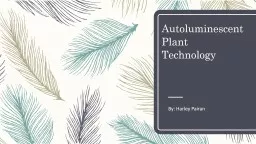/


Autoluminescent Plant Technology By Harley Pairan Autoluminescence in Bacteria Bioluminescent Bacteria are light producing bacteria found primarily in water based sources Traditional Purposes of ID: 773685
Download Presentation The PPT/PDF document "Autoluminescent Plant Technology" is the property of its rightful owner. Permission is granted to download and print the materials on this web site for personal, non-commercial use only, and to display it on your personal computer provided you do not modify the materials and that you retain all copyright notices contained in the materials. By downloading content from our website, you accept the terms of this agreement.
Autoluminescent Plant Technology By: Harley Pairan
Autoluminescence in Bacteria Bioluminescent Bacteria are light producing bacteria found primarily in water based sources. Traditional Purposes of Biolumenescence Attraction of mates Defense against predators Warning signals Bacterial Use of Bioluminescence Distribution
Biochemistry of bioluminescence The enzyme luciferase is responsible for catalyzing the chemical reaction of bioluminescence. The basic reaction for resulting blue/green light: FMNH 2 + O 2 + R-CHO -> FMN + H 2 O + R-COOH + Light (~ 495 nm) The lux operon and subsequent lux gene sequences control the synthesis of aldehydes for the reaction
Luminescent Plants of the Past Most “luminescent” plants have only ever been capable of their luminescence because of an exogenous application of luciferins or Salicylic acid Long term however these plants saw fading of the luminescence and a need for reapplication if wanting to achieve the desired effect again.
New Technology Development Dr. Alex Kirchevsky and his team took on the challenge of creating autoluminescent plantsUse two different lines of the Nicotiana tabacum transplastomic plants the lux operon from Photobacterium leiognathi was introduced. One line: Integration into the rps12/TrnV locus of the chloroplastSecond line: Integration into the Trnl/TrnA locusThe outcome? Those lines with chloroplast integration show autoluminescent phenotypes
How It Works
Results?
Future Potential Plants that are capable of autoluminescence have a big future ahead of them Use for lighting country backroads Use for cosmetic purposes of lighting yards similar to lawn ornaments without the burden of using electricity This could however lead to a shift in how predation functions in nature. Is it ethical?
References (1) Krichevsky , A.; Meyers, B.; Vainstein, A.; Maliga , P.; Citovsky , V. Autoluminescent plants. PLoS One 2010, 5 (11), 1–7.(2) Meighen EA (1991) Molecular biology of bacterial luminescence. Microbiol Rev 55: 123–142.(3) Wani, S. H.; Sah, S. K.; Sági, L.; Solymosi , K. Transplastomic plants for innovations in agriculture. A review. Agron. Sustain. Dev. 2015, 35 (4), 1391–1430.(4) Krichevsky , A. Bioluminescent Plants Comprising Bacterial Lux Operon and Methods of Making Same. (5) Krichevsky , A. (2013). U.S. Patent No. US 20130074221 A1. Washington, DC: U.S. Patent and Trademark Office.